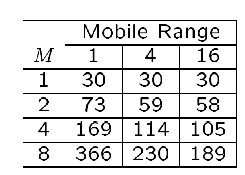
 |
JPL's Wireless Communication Reference WebsiteChapter:
Analog and Digital Transmission
|
Contributed by Peter M. Grant
Here, the performance of a CDMA system, based on the eigenfilter method and
a DPSK RAKE filter will be presented, using, as a quality measure, the mean
BER for a given user. A single cell system will be considered to assess the
number of active users who can be accommodated within the same RF band width
at acceptable multipath access interference levels. The following assumptions
have been made about the CDMA system:
The performance of different antenna array sizes is evaluated for M = 1, 2, 4 and 8 individual antenna elements. In each case, the maximum received signal value for a scattering width 2D is calculated, assuming the source bearing is in the range [30deg., 150deg.]. The results are shown for the desired user's BER vs total number of users in the Figure below.
The results demonstrate a significant performance improvement for a given number
of users, by increas-simpler ing the size of the antenna array. If a mean BER
of 10-2 is taken as the threshold of acceptable performance, the capacity according
to this measure increases from 30 users for 1 antenna to 189 for 8 antenna elements,
at a large mobile range.
Plot of error ratio against number of users in a 256 processing gain CDMA system for numbers of antenna elements M and mobile ranges, as defined before.
 |
For cellular systems, with a uniform distribution of users throughout the network, an additional noise term of approximately 50 of the single cell CDMA interference is present. This effect will reduce the capacity by approximately one third however it can be compensated for by including error-correction coding and data interleaving. In addition the system capacity may be doubled by using voice activity detection which only permits mobile when the user is speaking: typically, one person speaks during 40% of a telephone tion. Table 2 summarises the performance improvement over several values of mobile range.
CONCLUSIONS
Research by Peter Grant suggests that M antennas can multiply the reverse link by a factor of roughly M. Channel modelling aspects have been described: in urban areas, several channel taps are often resolvable. The significant channel taps or signals, observed at antenna arrays, may be modeled as the summation of array steering vectors.
The 2D RAKE filter or space-time processor is clearly a promising and thoroughly investigated approach to releasing an effective CDMA antenna array receiver. Several algorithms have been compared, with the eigenfilter approach performing consistently well. As the angular width of the channel response increases, the receiver is able to exploit more spatial diversity. All the algorithms are known to degrade in the presence of high Doppler spreads, particularly when the angular spread from the users is large. This limits the performance or data rate for highly mobile users but, in indoor environments, or for walking pace dense urban users, then these algorithms do give the increase in performance to provide higher data rate services to these users. The BER performance of an antenna array receiver has been estimated and significant capacity increases have been demonstrated.
The interaction of the reverse and forward links is important in practical systems, particularly to ensure that the forward link can handle the increased traffic that antenna arrays can offer on the reverse link.
It should also be noted that smart antenna techniques are sometimes applied in TDMA mobile communications. However, in these latter systems, the interfering users must be separated in space as these systems rely on the "space-division" multiple access concept which is somewhat distinct from the processor techniques discussed here. See e.g. smart antennas.